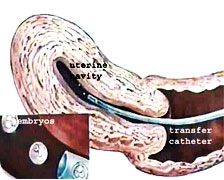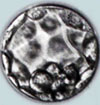The Timing of Embryo Transfer
During IVF the embryo transfer is usually carried out on day 2 or 3 following the egg collection. At this time the embryos are at the 2-8 cell stage of development. It is very difficult for embryologists to select accurately which embryos have the best chance of forming a pregnancy at such an early stage of their development but they are all carefully checked using a well-established grading system and the best ones are transferred in the hope that at least one will implant and result in a live birth.
Sometimes two or more embryos will form ongoing pregnancies and the result is a multiple (twin or triplet) pregnancy. Multiple pregnancies are associated with an increased risk of complications, such as pre-term delivery and its associated problems to the babies. It is preferable therefore to limit the number of the embryos to be transferred say to a maximum of two very good embryos so that those patients who become pregnant only have one or two babies.

A blastocyst is a highly developed embryo that has divided many times into a large number of cells. An embryo reaches this advanced stage of development on day five following insemination.
We offer blastocyst culture and transfer to patients undergoing IVF subject to a number of essential conditions being met. This technique enables us to maintain, or even increase, our IVF success rates whilst significantly decreasing the risk of multiple pregnancy (twins or triplets)
What are the advantages of blastocyst transfer?

Whilst the majority of fertilised eggs will develop into 4-cell embryos, only about half of these embryos will develop to the important blastocyst stage. Therefore, blastocysts are a more “select” group of embryos with a higher chance of implantation. Because they are more likely to form a pregnancy, single or double embryo transfer can be undertaken without reducing the chance of pregnancy.
Which patients will benefit from blastocyst transfer?
Deciding which patients will benefit from blastocyst transfer is a rapidly developing area. Nile Fertility Centre offers blastocyst transfer to those patients who we predict will develop a large number of embryos and who would have a high risk of a higher multiple pregnancy if more than two embryos were transferred. Also, we will recommend it to older patients (age 38 to 44 years) who have a large number of embryos but who have a lower chance of pregnancy because of their age. Blastocyst transfer will allow us better selection of the embryos to transfer.
Your pregnancy test will be due 12 days following the Blastocyst Transfer. We will advise you of the date at the time of the transfer.


